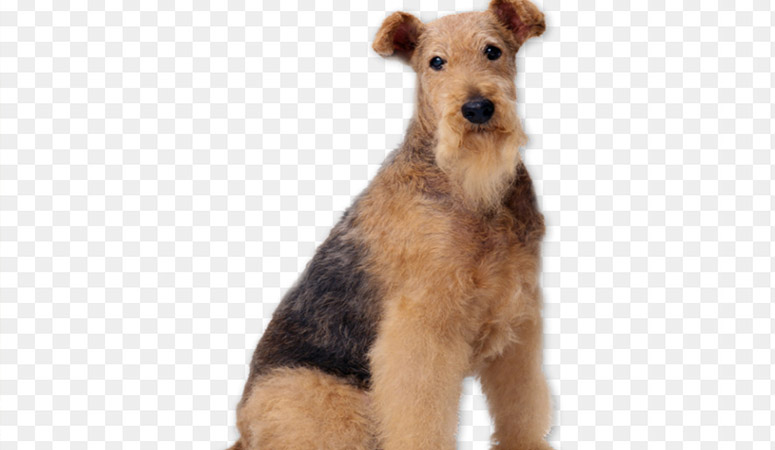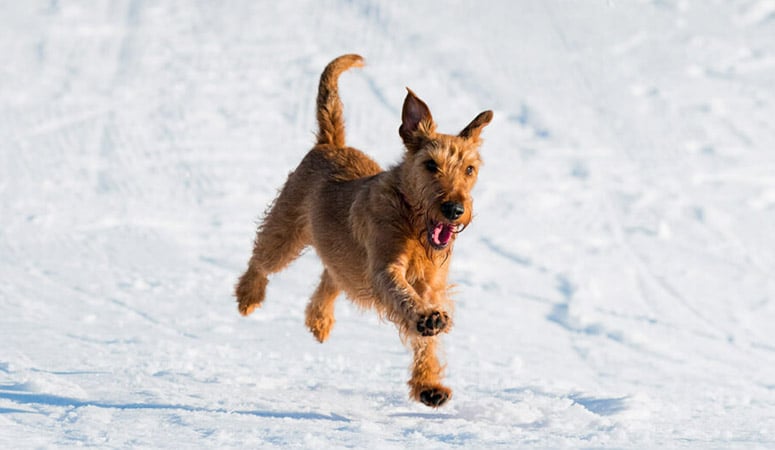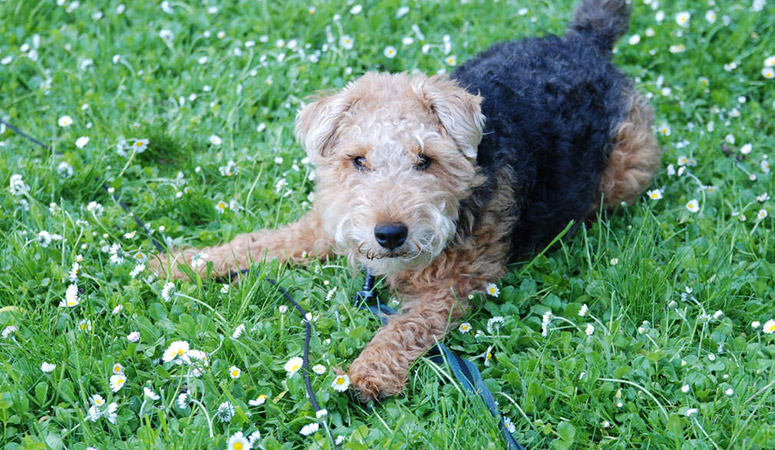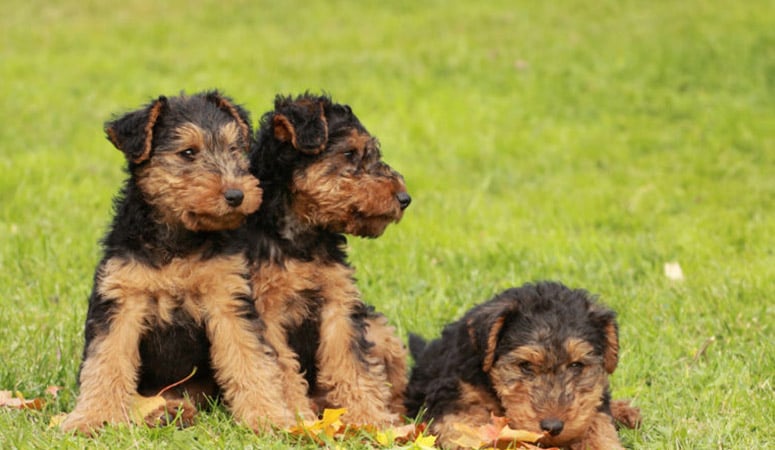Welsh Terrier
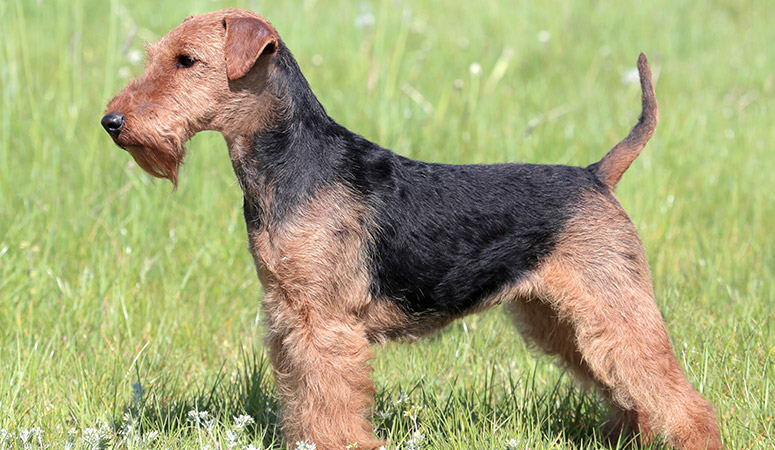
Here comes a Welsh Terrier. Naughty and playful at their young age, it takes some efforts for owners to train them to behave well. However, Welsh Terriers can be good family members after owners have them understood that they are not the one in charge of the household.
| Other Names | Non |
| Color | Black & Tan, Grizzle & Tan, Black, Grizzle & Tan |
| Height | Males: 15-16 inches. Females: 14-16 inches. |
| Weight | Males: 19-22 pounds. Females: 19-22 pounds. |
| Life Span | 12-15 years |
| Personality | Friendly, Spirited, Intelligent |
| Exercise | Energetic |
| Origin |
| Popularity | #110 |
| Groom Needs | 2-3 Times a Week Brushing/Occasional Shedding |
| Kids Friendly | Yes |
| Dog Friendly | Yes with supervision |
| Watch Dog | |
| Family Dog | |
| Litter Size | 2-8 puppies |
Welsh Terrier Pictures
Welsh Terrier Video
Introduction
It is true that the compact Welsh terrier does look much the same as the Airedale, but just in miniature form, doesn’t he? This Welshie stands around 15 inches at the shoulder and weighs around 20 pounds. He’s always alert and on the go as well because he is full of tenacity and inquisitiveness – so remember he needs a garden that is fenced in. He is very independent as you can see from his inquisitiveness and will take advantage of that independence if allowed to do so. But he’s also very amiable, friendly and outgoing. Proper socialization will develop his self-confidence even more. He is inclined to bark incessantly if he is not properly managed with plenty of exercise, attention, and activities. This will help to prevent him from becoming destructive and chewing on soft furnishings for instance. Even though small, the Welsh Terrier will need about an hour’s exercise each day. Daily walks and access to a garden where he can run, explore, and smell things keeps him interested and excited. Their coats are black and tan in color and require clipping every few months – it’s a weather-resistant double coat consisting of a hard, wiry overcoat as well as a soft undercoat. It is recommended his coat should be brushed 2-3 times a week.
Living with Welsh Terrier
Though hardly shed hair, Welsh Terrier still need regular grooming. Light hair shedding makes owners free from troubles. Clumps of hairs will rarely fall out for Welsh Terriers. So owners can brush them frequently without worry about the cleaning of hairs. Three-times-a-week brushing can be appropriate. A soft brush or a hound glove can be suitable for owner to groom them. But owner should bath them beforehand. It’s also advisable for owners to have Welsh Terriers’ coat stripped. Stripping knife can be applicable to coat-stripping. Ears of all dogs should be checked regularly in case of any signs of infections, irritations or wax build up. Owners can use a vet-approved cleanser to clean dogs’ ears. To make them clean overall, teeth should also be brushed to avoid gum disease. Regular nail-trimming is also important.
Welshies are energetic even they are small in size. They need moderate vigorous activities to run off their energy. Welsh Terriers are high-energy, once-a-week all-out running can be applicable to them. Owners can take them out for some runs and jumps. They might easily get bored when kept at an apartment. Apart from vigorous exercise, owners should provide Welshies with brisk walks three or four times per day. This kind of amount of exercise is suffice for this breed to grow up sane. As a wonderful family companions, owners should not always keep them at home. Moderate interactive fetch games can add the emotional connection between dog and family members. If kept at home for too long, they might be terrible housemates. Stimulating toys can be also applicable to them if owners are too busy to take them outdoor at inclement weather.
Though not critical about food, Welsh Terriers need to be fed on healthy and premium dog food. They are active, and they frequently take vigorous exercise. So it’s advisable to feed them appropriate amount of food according to their amount of exercise. Dry kibble which is of high quality can be suitable for them perfectly. Owners need to get aware that certain human food can cause danger to dogs. Basically, human food that contain many salt and oil might do harm to their kidney and liver. Chocolate can cause increased risks of brain, sometimes even life-threatening. Sooth decay, gum disease and plaque buildup might occur if fed on soft food. If dogs are overweight, owners should watch dog’s calorie consumption and weight level regularly. If owner find it difficult, it’s advisable to visit vet. Last but not the least, fresh and clean water should be offered anytime and anywhere.
Welsh Terriers are basically in good health, but some are prone to suffer from diseases. Eye trouble can ocassionaly appear. Lens luxation and glaucoma will cause dogs in pain and inconvenience overall. They are also prone to be allergenic about some certain things. So owners should concern about which food might cause these symptoms. Seizures is also prone to appear, so owners should try to ask veterinarians for advice. However, the Welsh Terriers puppies are not fragile that much. It’s the key of healthy food and moderate exercise that helps make Welsh Terriers grow up sane. Breeders will screen their stock to make sure every dog is healthy. Under the help of responsible breeders, a new puppy buyer can pick up a healthy and energetic dog.
Total Annual Cost: $2689
Cost is estimated for the first year and may vary depending on many factors, such as dog food, health care, leash, collar, licensing, possible fencing, crates, training and obedience classes, dog-walking, grooming, treats, toys, flea, tick, and heart-worm meds, microchips, etc.
It takes trainer little efforts to train Welsh Terriers, as they are rather smart. Training can be quite easy for an novice trainer. However, trainers should be patient enough and persistant. Certain training method should be carried out. There should be some emotional connection between trainer and dog. As this breed is passionate and stubborn, trainer need to make the training process fun and rewarding. Welsh Terriers are easily to get bored with repetitive training direction. So trainer need to offer some intervals between each training peroid. Positive reinforcement-method can of great importance, as dogs like praise which comes with some treat. However, trainer should feed them appropriate amount of treat. Too much feeding during training period might cause overweight or bloat. The Welsh Terriers should accept training at a young age, as they are naughty puppies. Early training should be necessary so that owners will rarely worry about Welsh Terriers’ headstrong behaviors.
History
The Welsh terrier originates from Wales.
He was developed separately from the Airedale Terrier – the Welshie is the older of the two breeds by well over a hundred years.
The Welsh terrier was originally called a Black and Tan Wirehaired Terrier, developed to hunt for badgers and foxes. As the Welshie continued to develop in Britain they continued to be used as rugged, sturdy hunting dogs than being shown in the ring.
He was classified as a Welsh Terrier by the Kennel Club of England.
Then in 1888, these dogs began arriving in the USA and by 1901 they had established a good footing in the country, with their popularity growing at a steady pace.
When John F. Kennedy was president, the family had a beloved Welshie as a pet; he was called Charlie – he was given the dog by his wife during the presidential campaign. Charlie was so close to JFK that Mrs. Kennedy called him “Jack’s dog.” Charlie loved to even swim laps with the president, and enjoy long walks with the presidential couple at night, discreetly watched over by the Secret Service.
The American Kennel Club (AKC) recognized the Welsh Terrier in 1888.
Helpful Information
Breed Club: The Welsh Terrier Club of America
Breed Club Link: https://welshterrier.org/
Breed Club Rescue:
Breed Club Rescue Link: https://welshterrierrescue.com/available-for-rescue/representative-near-you/

